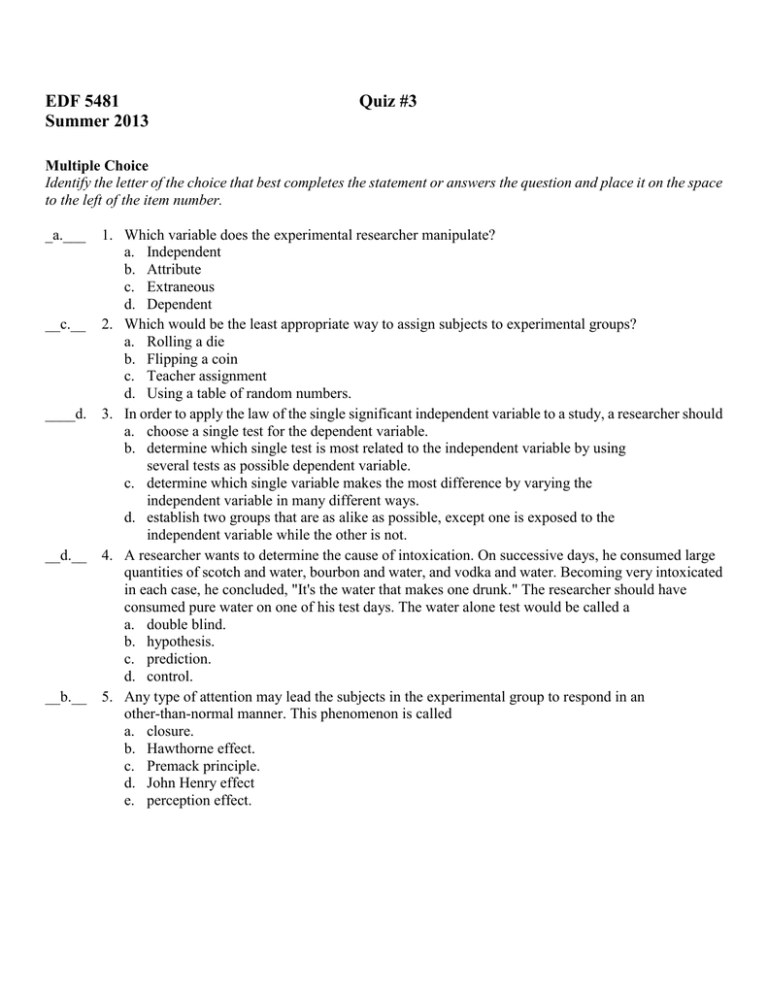EDF 5481 Quiz #3 Summer 2013 Answer Section
advertisement

EDF 5481 Summer 2013 Quiz #3 Multiple Choice Identify the letter of the choice that best completes the statement or answers the question and place it on the space to the left of the item number. _a.___ __c.__ ____d. __d.__ __b.__ 1. Which variable does the experimental researcher manipulate? a. Independent b. Attribute c. Extraneous d. Dependent 2. Which would be the least appropriate way to assign subjects to experimental groups? a. Rolling a die b. Flipping a coin c. Teacher assignment d. Using a table of random numbers. 3. In order to apply the law of the single significant independent variable to a study, a researcher should a. choose a single test for the dependent variable. b. determine which single test is most related to the independent variable by using several tests as possible dependent variable. c. determine which single variable makes the most difference by varying the independent variable in many different ways. d. establish two groups that are as alike as possible, except one is exposed to the independent variable while the other is not. 4. A researcher wants to determine the cause of intoxication. On successive days, he consumed large quantities of scotch and water, bourbon and water, and vodka and water. Becoming very intoxicated in each case, he concluded, "It's the water that makes one drunk." The researcher should have consumed pure water on one of his test days. The water alone test would be called a a. double blind. b. hypothesis. c. prediction. d. control. 5. Any type of attention may lead the subjects in the experimental group to respond in an other-than-normal manner. This phenomenon is called a. closure. b. Hawthorne effect. c. Premack principle. d. John Henry effect e. perception effect. _a.___ ____a. __d.__ __a.__ __c__ 6. Failure to control history and maturation is a definite weakness. a. One-group, pretest-posttest design b. Randomized subjects, posttest only, control-group design c. Randomized subjects, pretest-posttest design control-group d. Randomized Solomon four-group design e. Counterbalanced design 7. In a randomized subjects pretest-posttest control group design, results might best be analyzed through a. ANCOVA. b. ANOVA. c. change scores. d. t tests. 8. The Solomon three- and four-group designs were developed in order to control the threat of a. differential measurement. b. history. c. maturation. d. pretest sensitization. 9. The main disadvantage of a counterbalanced design is the lack of control for a. carry-over effect of treatment. b. internal validity. c. preexisting differences. d. pretest sensitization. 10. The term "confounding" refers to the presence of a. a variable which is controlled and does not affect the outcome of a study. b. two independent variables in a study. c. a variable that is not controlled which affects the outcome of a study. d. two dependent variables in a study. EDF 5481 Summer 2013 Answer Section Quiz #3 MULTIPLE CHOICE 1. 2. 3. 4. 5. 6. 7. 8. 9. 10. ANS: ANS: ANS: ANS: ANS: ANS: ANS: ANS: ANS: ANS: A C D D B A A D A C







